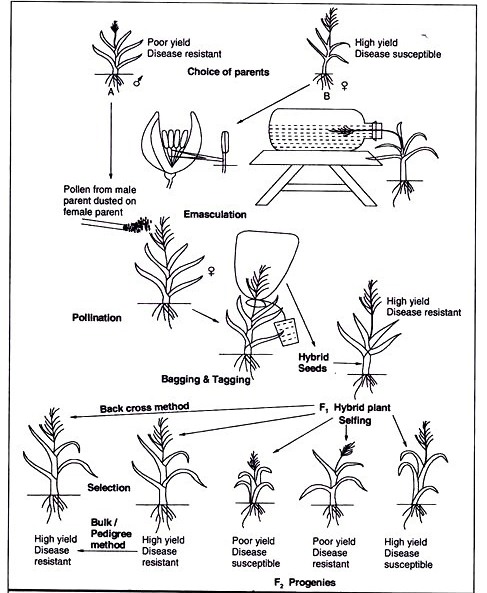WHAT IS HYBRIDIZATION- AIM & TYPES
INTRODUCTION
- Simply the crossing of two plants or lines of dissimilar genotype is known as hybridization.
- It may be inter-specific or intraspecific hybridization.
- The main objective is to create genetic variation for the purpose of getting one or more new characters in the hybrid.
- Now a day, hybridization is the most common method of crop improvement.
Interspecific Hybridization– It is the process of interbreeding between individuals of different species.
Intraspecific Hybridization– It is the crossing of genetically divergent individuals from the same species.
IMPORTANT POINTS
- Offspring produced by hybridization may be fertile, partially fertile, or sterile. Plants of the same species cross easily and produce fertile progeny. Wide crosses are difficult to make and generally produce sterile progeny because of chromosome-pairing difficulties during meiosis.
- The seed or progeny resulting from hybridization is called F1 (first filial generation) or hybrid. And the progeny of F1, obtained from selfing of F1 plants and the subsequent generations are called segregating generations.
- The concept of hybrid vigor or heterosis is resulted from hybridization. Heterosis (or heterozygosis) occurs when the hybrid outperforms its parents for a certain trait. The outstanding example of the exploitation of hybrid vigour through the use of F1 hybrid varieties has been with corn (maize).
- Sex in plants was discovered by Camararious (1694). Thomas Fairchild produced the first hybrid in 1717, commonly known as Fairchild’s mule, by crossing sweet William with carnation.
OBJECTIVE
The main objective of hybridization is to create genetic variation, when two genotypically different plants are brought together in F1. Segregation and recombination produce several new gene combinations in F2 and the later generations, i.e., the segregating generations.
The aim of hybridization may be the transfer of one or few qualitative characters, the improvement in one or more quantitative characters, or use the F1 as a hybrid variety.
TYPES OF HYBRIDIZATION
Based on the taxonomic relationship of the parents involved in hybridization, it is of two types.
- Intervarietal/Intraspecific Hybridization- When parents are of the same species that may be two strains, varieties or races of the same species. This is most commonly used in crop improvement. This type of hybridization may be simple or cross depends on number of parents involved.
- Distant Hybridization- Here crosses are made between different species of the same genus or of different genera. Interspecific cross involved crossing between two different species of the same genus, whereas, intergeneric cross means the cross between two different genera. Generally this method is used to transfer one or few simply inherited characters like disease resistance to a crop species.
PROCEDURE OF HYBRIDIZATION
There are seven steps involved in the process of hybridization.

- Choice of parents
- Evaluation of parents
- Emasculation
- Bagging
- Tagging
- Pollination
- Harvesting and storage of F1 seed